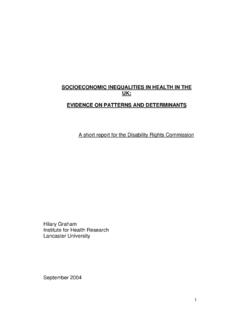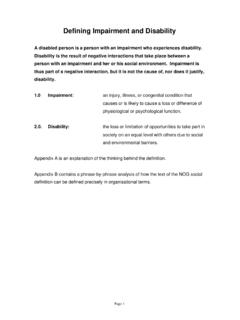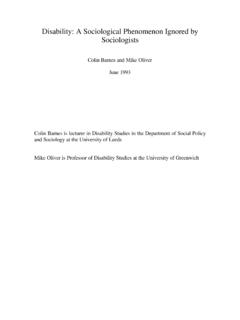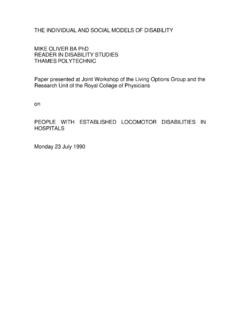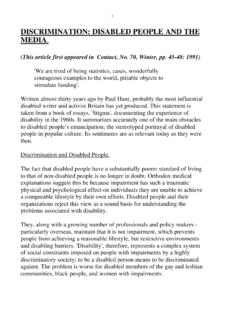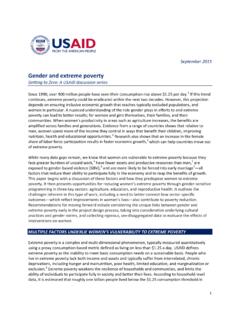Transcription of GENDER AND DISABILITY
1 GENDER AND DISABILITY (Draft entry for the forthcoming Sage Encyclopaedia of DISABILITY written in 2004) Helen Meekosha Senior. Lecturer School of Social Work, University of New South Wales, Sydney. NSW 2052 Australia. tel: INT+61 (0)2 9385 1862 fax: INT+61 (0)2 9662 8991 April 2004 1 The Meaning of GENDER GENDER is the structure of social relations that centres on the reproductive arena, and the sets of practices (governed by this structure) that bring reproductive distinctions between bodies into social processes (Connell 2002) Why do we need to understand about GENDER in DISABILITY studies ? What is the relationship between GENDER and DISABILITY ? How are men s and women s experience of DISABILITY similar or different ?
2 Indeed are GENDER and DISABILITY such different concepts given that women have been seen as deformed men and DISABILITY is often associated with femininity (Thomson 1997)? In order to understand these relationships we must examine the meaning of GENDER . GENDER is closely connected to sex, though there are different ideas about Sex is usually understood as relating to the biological and physiological body. GENDER is often understood as the cultural interpretation of sexed bodies, embedded in the whole apparatus of a society s roles and norms. Thus a sex / GENDER binary is set up parallel to that of nature /culture. GENDER , as a relationship between sexes in societies, is usually seen as operating hierarchically - men being more powerful and dominant , while women are less powerful and weaker.
3 These power relations produce stereotypes of masculinity and femininity - traits and behaviour that are expected of men and women(see further below). Role expectations of women as the nurturer, men as breadwinner and so on, define approved ways to perform GENDER . 2 While the simple binary has been persuasive, we now know that there are more than two biological sexes (transexuality, and people with congenital ambiguous sex organs) , and many ways of performing GENDER . Far from being a simple dichotomy GENDER turns out to be a complicated and evolving realm of meaning making among people with sexed bodies. Gay, lesbian and trans- genders suggest the fluidity of these performances and their capacity to change over time and across societies.
4 Many of these questions go to the heart of understanding DISABILITY . The simple binaries have become complicated as we learn more about the social construction of bodies, and the biological influences on human behaviours. Nature and culture, sex and GENDER , have their reflection (though not mirror images) in the distinctions between impairment and DISABILITY . Impairment has been used to describe functional limitations accruing to an individual as a consequence of embodied differences; while DISABILITY has been used to refer to a system of social relations that limit the individual in their daily lives. This simple binary, while heuristically useful, masks the inter-penetration of the social and the biological (Schriempf 2001 (Fall0).)
5 Gendered analysis of DISABILITY has been particularly valuable in demonstrating the web of social and biological factors that disable people, not just women. Gendered analyses address the processes through which both femininity and masculinity are constituted, and the implications of these processes for people with impairments, thereby moving beyond the particular focus of feminism on the experiences of women. (Gerschick 2000) The Gendered Experience of DISABILITY Disabled people have often been represented as without GENDER , as asexual creatures, as freaks of nature, 3monstrous, the Other to the social norm. In this way it may be assumed that for disabled people GENDER has little bearing. Yet the image of DISABILITY may be intensified by GENDER - for women a sense of intensified passivity and helplessness, for men a corrupted masculinity generated by enforced dependence.
6 Moreover these images have real consequences in terms of education, employment, living arrangements, and personal relationships, victimisation and abuse that then in turn reinforce the images in the public sphere. The gendered experience of DISABILITY reveals sustained patterns of difference between men and women. For people with disabilities gendering is conditional (Gerschick 2000).Age of onset combined with the type of impairment leads to GENDER expectations. Gendered studies of DISABILITY in western industrial nations reveal the following patterns of public and private dimensions. In the public arena : more women than men are classified as disabled, particularly as ageing populations mean that larger proportions of the elderly are women with impairments; while disabled people are much more likely to live in poverty, women are likely to be poorer than men; especially in developing countries where women are often heads of households.
7 Younger disabled women achieve lower educational outcomes than men; disabled women are less likely to be in the paid workforce than either men with disabilities for non disabled women, and in general have lower incomes from employment; 4 women are less likely to have access to rehabilitation, and to employment outcomes when they do receive rehabilitation; the age distribution for women is different to men (older versus younger); the type of impairments are different for women and men, with women more likely to experience degenerative conditions, while men are more likely to experience injury-related events; women are more likely to experience public spaces as intimidating and dangerous.
8 In the private and familial arena disabled women are more likely to be living on their own, or in their parental family than men; disabled women are more likely to be divorced and less likely to marry than men with disabilities women are more likely to face medical interventions to control their fertility; women are more likely to experience sexual violence in relationships and in institutions. women experience more extreme social categorisation than men, being more likely to be seen either as hypersexual and uncontrollable, or de-sexualised and inert. Moreover in the developing world, GENDER patterns in relation to DISABILITY indicate that: poverty hits harder on women and girls due to patriarchal property ownership structures aid is less likely to reach women and girls who are less able to compete in situations of scarcity 5 disabled women are more vulnerable to domestic violence disabled girls are likely to find their access to education even more limited than girls in general women disabled by war have few resources to survive disabled women who are sexually abused are likely to have few if any social supports or options disabled women are less likely to be accepted as refugees by industrially-advanced countries (eg Australia prohibits the immigration of people with disabilities).
9 (Abu-Habib 1997; Meekosha and Dowse 1997; Snyder 1999; Charowa 2002) GENDER has been widely used within the humanities and social sciences as both a means to categorise differences, and as an analytical concept to explain differences. In both the humanities and social sciences , feminist DISABILITY studies has emerged partly as a result of attempts to explain gendered experience of DISABILITY and partly as a challenge to contemporary feminist theory on GENDER which fails to take account of DISABILITY such as the work of Judith Butler (Butler 1990; Butler 1993). The Psyche and GENDER DISABILITY has been used as a powerful metaphor in psychology, particularly as a means to assign to women the status of incomplete or deformed men.
10 In addition, GENDER stereotypes have been used to characterise disabled people, particularly men who have been presented as feminised and lacking masculine traits. These approaches have confused the conceptual difference between DISABILITY and GENDER . 6 Gendered analyses of DISABILITY have tried to move beyond these metaphors, to create a disciplined account of the impact on the gendered psyche of disabling social relations. Here four elements are presented- the development of the normal individual; the impact of disabling events; support for the survival of the disabled psyche; and strategies for normalisation and social role valorisation. Psychological models of individual development are increasingly taking account of GENDER -formation.
